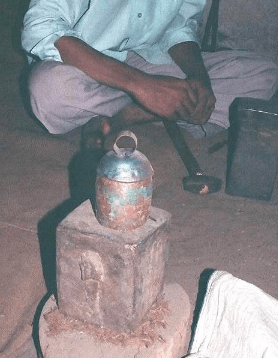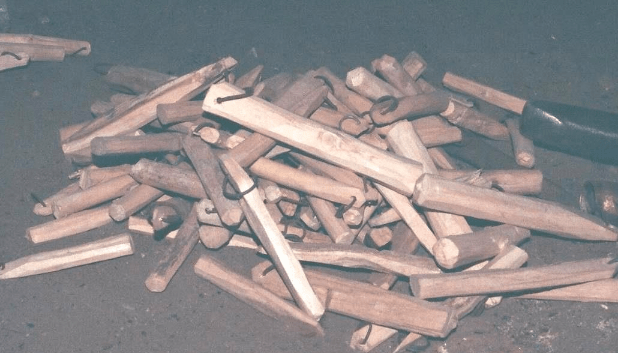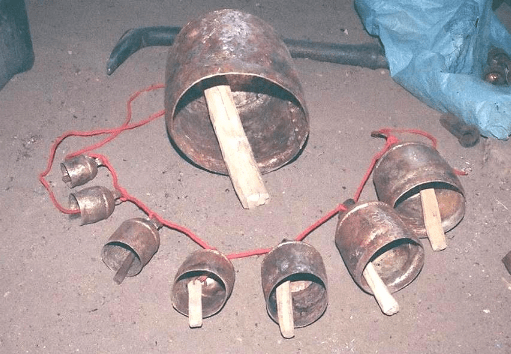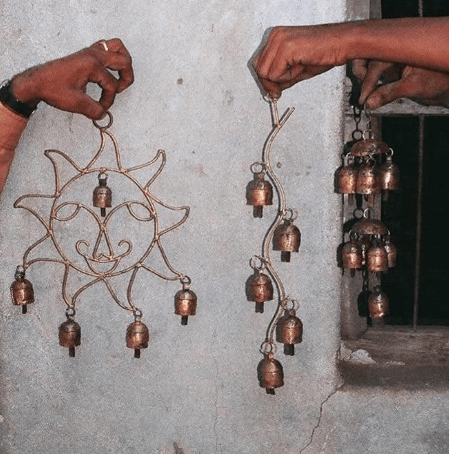Handmade Copper Bell Craft
The art of bronze casting has been practiced in India for more than five million years. Copper and bronze were perhaps the earliest non-ferrous metals that man-shaped into tools. Metal is part of the Indian mystique as each metal has its own alchemic and healing powers.
The availability of different metals and their amenability to being worked into different forms has made metals the base for a variety of decorative techniques such as inlay, metal casting, carving, appliqué, etc.
Metal craft has also been an integral part of Indian culture. The lotas or water pitchers are found in almost all parts of the country. The urli, a bell-metal vessel, in Kerala is a basic element of its culture.
The metal-based lamps in various shapes and designs are part of the Indian traditions and rituals. In Ladakh, decorative kitchen stoves are made purely by hand. In south India, metal icons, especially of bronze, are believed to absorb the charged energy of the Divine and are stored in the inner sanctum of a temple where the icon is installed.
Copper-coated iron bells from Kutch in Gujarat were made traditionally in Sindh, now in Pakistan. The art has been passed down over the generations. At that time, the bells made were exchanged for wheat, vegetables, milk, pots and pans or clothes.
It was a natural means to social and financial independence. These bells were used at entrances to homes and were also hung around the necks of grazing animals like cows and goats. Locally, they still serve the same purpose.
Regions of Production of Copper Bell Craft
Copper bells are now being made only in two villages in Bhuj, Gujarat. These are Nirona and Zura. In Rajasthan, what one gets is slightly different. The iron clapper that is used inside the bell is made of metal instead of wood.
In Saharanpur, Uttar Pradesh, the shape and technique used are different as compared to what one finds in Bhuj. Most of the bell making is done in Kutch, Gujarat by the Lohars of the Muslim community.
The entire family is involved in the process, though women only do the mud coating on the bells before they are put into the oven. Men perform the technical and critical tasks of shaping the bells and setting their sound.
Raw Materials of Copper Bell
•Iron scrap
•Copper
•Brass
•Cotton
•Coal is needed for baking.
•Wood for the clapper
Iron scrap is bought from Bhuj and also collected locally in the village. Copper and brass powder is available in Bhuj. Sourcing raw material for bells is not a problem.
Tools of Copper Bell Craft
Different sizes of hammers are also used to beat the metal and for tonal setting. Most of the tools used by bell makers are made by them, especially the ones used for sound and tonal settings.
•Khilli: This piece of iron bar is fitted perpendicular on the ground and used for various functions.
•Aran: This is also made out of solid iron. This tool has a flat and broadened surface at the top. It is used for making surfaces flat and bending the sheet at 90̊.
•Killi: It is a longer iron bar with an upright bend in order to reach the innermost surface from inside. The longer upright bent bars are used to support the side wall of the bigger bells.
Making of the Copper Bell Craft
The making of a copper bell can be divided into three parts:
Main Cylindrical Hollow
The body of a bell is made by shaping rectangular strips of iron plates into a cylindrical hollow. The length and width of the iron strip used depends on the size of the bell to be crafted.
The stone on which the iron strips are shaped is also special. Holes of various sizes are made in it to fit the iron strips for bells of various sizes.
Semi-circular Hollow
the cylindrical body is topped with a semi-circular shaped, half -orange hollow crown, which is made from a small iron strip. The dome-like top looks like the inside of a bowl and is welded perfectly with the cylindrical body of the bell.
Loop
The clasp loop at the top of the bell (through which is passed the rope or twine from which the bells hangs) is attached. A very narrow iron strip is shaped like a horseshoe; both its ends are then pushed in through the bell top to the inside of the bell.
Inside the bell, both the ends are twisted together and locked, creating a thin circular or oval loop of which half is atop the bell, and the other half inside the bell. The textured and burnished copper coating is created through several stages, each involving a distinct process.
The uncoated iron bell is first dipped in a solution of mud and water (mostly women do this particular part of the process) and then the bell is rolled in the mix of brass and copper powder. This metallic powder sticks to the bell as it is covered with a wet mud solution.
Bits of cotton are soaked in the mud and water solution, after which they are stretched into dense pancake-like shapes. The bell, with brass and copper powder clinging to it, is wrapped in the cotton pancake and baked in a bhatti for 30-45 minutes.
The length of time that the bell is kept in a bhatti depends on the size of the bell, with the smallest size being baked for half an hour to 45 minutes and the largest for more than an hour.
If the bells are small four or five can be put together in the fire but the bigger bells are baked one at a time.
After it has been baked, the cotton wrapping is peeled off, and the excess mud sticking to the bell is rubbed off. The metal-coated outside is buffed to create a lustrous polished ton.
Finally, a shaped piece of wood, usually shisham, both dense and hard, is hung in the cylindrical part of the bell structure converting the bell hollow into a musical piece. The solid wood piece is attached to the bell’s dome roof with the help of a thin iron hoop that is pierced through the wood at one end.
Sound and Tonal Settings of Copper Bell Craft
Each artisan gets a different and distinct tone from the bells that he makes. Just by listening to the sound an artisan can tell who has made the bell in his village.
The sound that emanates from the bell is actually set by the bell maker with the help of an instrument called ekalavai. Each bell maker makes his own ekalavai.
The sound that each bell emanates depends on how well the metal is beaten, the shape and curvature of the bottom rim of the bell. On no account can different sized bells be combined in a single sequence or jhumar.
This is owing to the fact that mixing different sized bells would lead to a conflict in tonal settings, thus creating a cacophony. The need for tonal harmony also means that the rims of all the bells in a jhumar be shaped identical to each other.
A well-crafted jhumar is, thus, a collection of bells that are as similar, if not identical, in shape, size and tonal settings.
In the local market (in Bhuj and Nirona) bells are often referred to by their original names such as chota-paila, paila, dingla, do-dingla rather than their sizes.
These names are the local currency equivalents for which the bells could be bought at that time. Within each size, the shape of the bells can vary and the rims are designed differently. Some are straight-edged, while others are worked in an undulating pattern and even in multiple rows of undulating lines.
Sometimes the rims are reinforced or made heavier by adding thin strips of metal to create a new sound variation.
Copper Bell: Products and their Uses
Traditionally bells were sold to tie them around cattle and other grazing animals, so that if they drifted far off while grazing one could trace them. Bells were also put at the entrance to a house. In the past few years their demand in the urban market has increased.
Various products are being made to cater to the urban taste. Key chains and jhumars in various designs and sizes are very popular. Usually bells of small sizes are used to create a jhumar. They are used as decorative items. People buy bigger bells to hang outside the house. They are in great demand in the US.
Primary Market of Copper Bell Craft
These bells and jhumars are sold in the local markets–Nirona, Jhura and Bhuj. They are used as decorative musical items, somewhat like chimes, all the more since their tonal quality is meticulously crafted. Government emporia have also started buying these from the local producers.
Some tourists who manage to reach the villages also contribute toward the sales. However, maximum sales happen at the exhibitions and fairs in metros and when orders are made during these exhibitions.
The demand has increased in the last decade and many new products have been introduced that were not there two decades ago.








